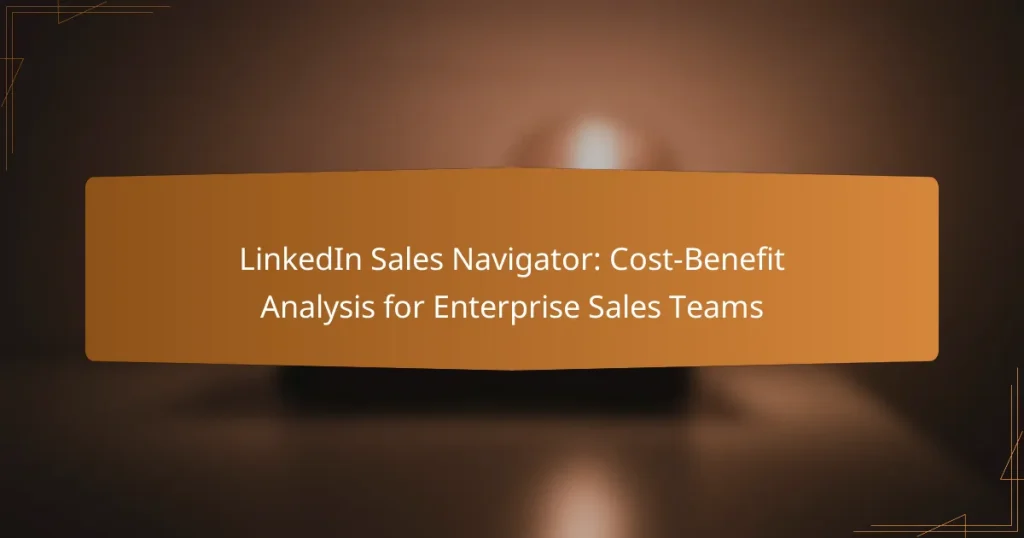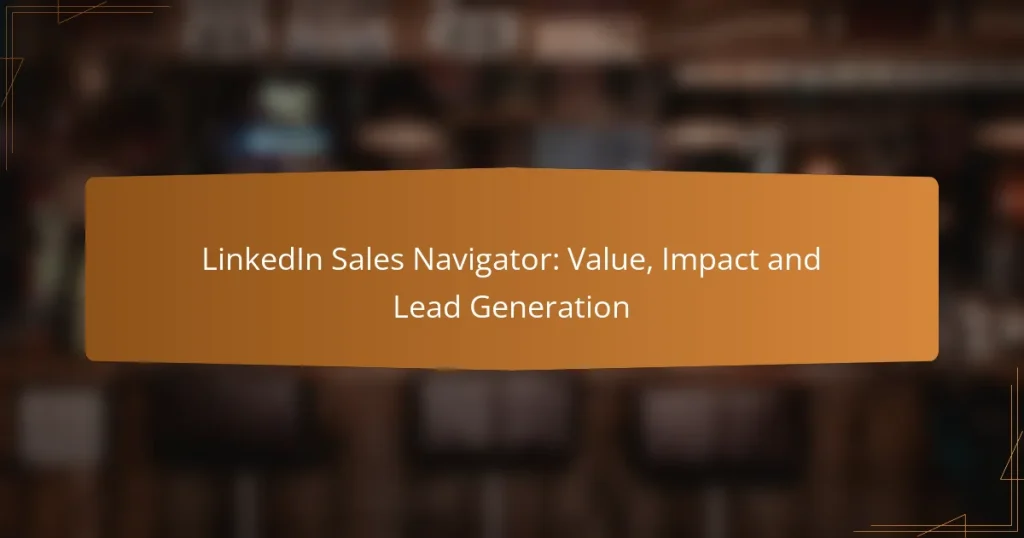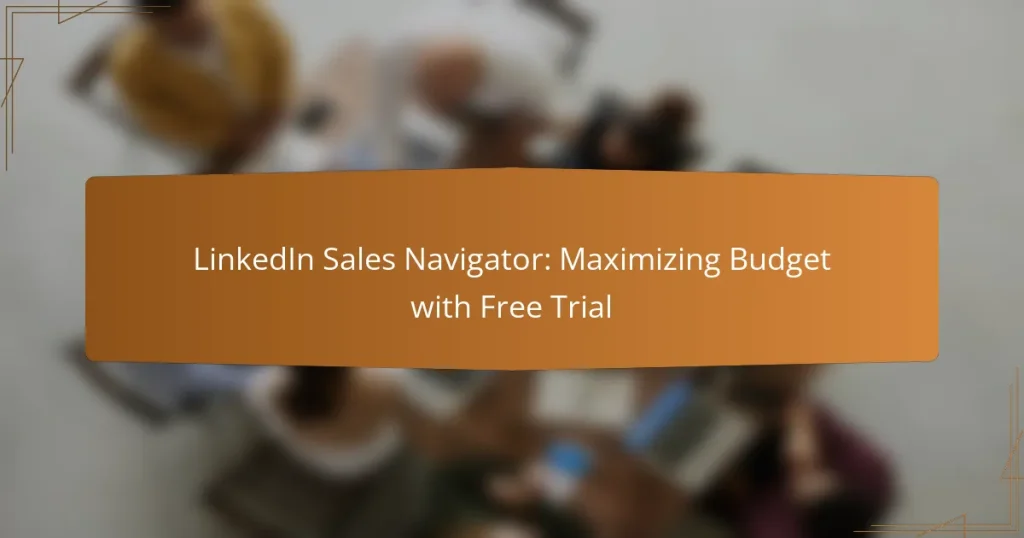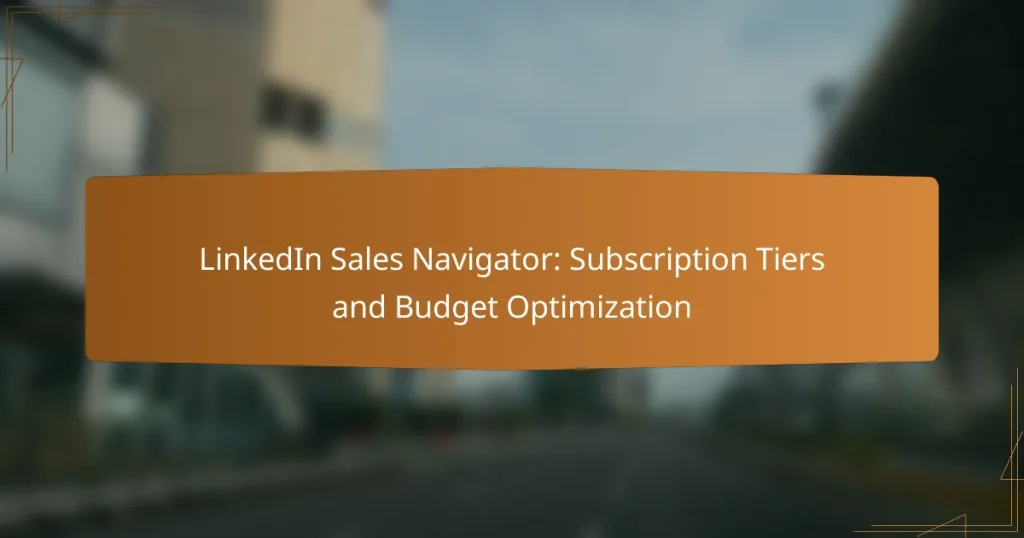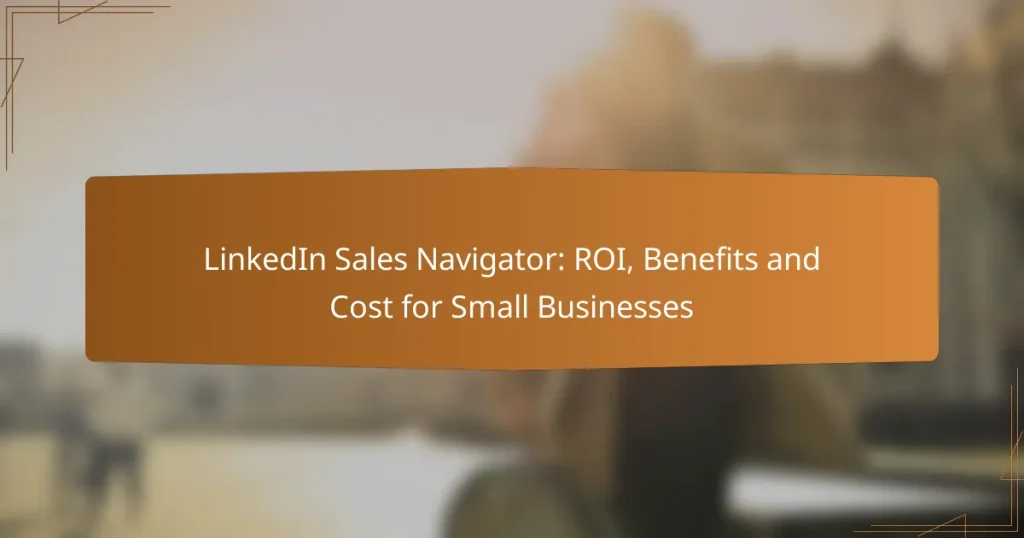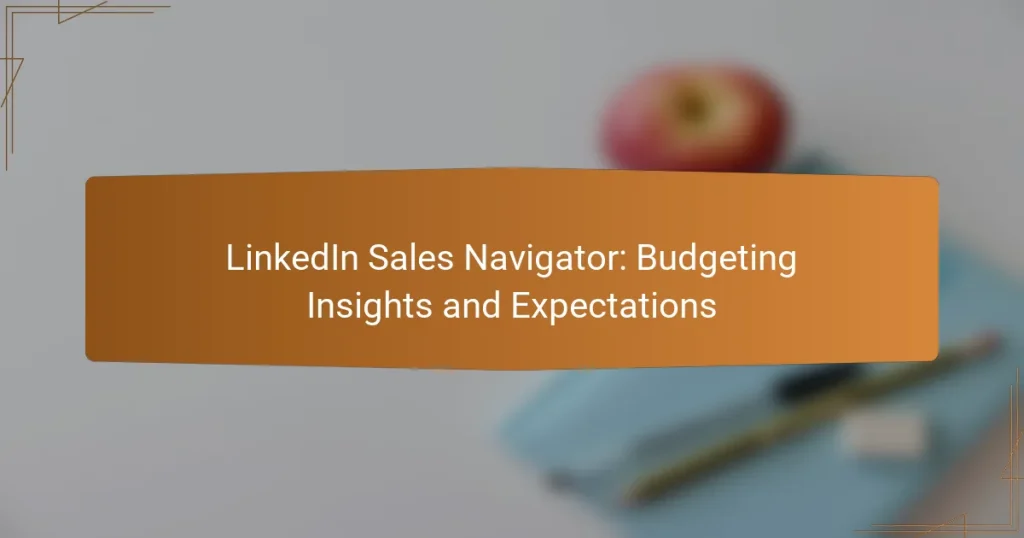LinkedIn Sales Navigator is a powerful tool for lead generation, offering advanced search capabilities and insights that enhance efficiency for sales teams targeting specific industries or roles. Its features, including real-time analytics and integration with the LinkedIn ecosystem, contribute to its cost-effectiveness, allowing businesses to optimize their sales strategies and improve return on investment. However, the overall value may vary depending on individual business needs and usage scenarios compared to other sales tools.
LinkedIn Sales Navigator: Value, Impact and Lead Generation
LinkedIn Sales Navigator: Maximizing Budget with Free Trial
LinkedIn Sales Navigator: Subscription Tiers and Budget Optimization
LinkedIn Sales Navigator: Long-Term Savings for Sales Professionals
LinkedIn Sales Navigator: ROI, Benefits and Cost for Small Businesses
LinkedIn Sales Navigator: Budgeting Insights and Expectations
How cost-effective is LinkedIn Sales Navigator for lead generation?
LinkedIn Sales Navigator is highly cost-effective for lead generation, particularly for businesses targeting specific industries or roles. By providing advanced search capabilities and insights, it allows sales teams to connect with potential clients more efficiently than many traditional methods.
High ROI through targeted outreach
Sales Navigator enables users to identify and engage with leads that fit their ideal customer profile. This targeted outreach can lead to a higher return on investment (ROI) compared to broader marketing strategies. For instance, businesses often report conversion rates that are significantly higher when using tailored messaging based on insights from Sales Navigator.
Utilizing features like lead recommendations and account insights, sales professionals can prioritize their efforts on high-potential leads. This strategic focus not only saves time but also increases the likelihood of closing deals, ultimately enhancing overall sales performance.
Cost savings compared to traditional methods
Compared to traditional lead generation methods, such as cold calling or mass emailing, LinkedIn Sales Navigator can offer substantial cost savings. While traditional methods may require extensive manpower and resources, Sales Navigator streamlines the process, allowing teams to work more efficiently.
For example, a company might spend hundreds of dollars on a single cold calling campaign, whereas a Sales Navigator subscription can provide access to a vast network of potential leads for a fraction of that cost. Additionally, the ability to track engagement and refine approaches based on data further reduces wasted efforts and expenses.
What are the key features that enhance cost-effectiveness?
LinkedIn Sales Navigator offers several features that significantly enhance its cost-effectiveness for businesses. By leveraging advanced search capabilities, real-time insights, and analytics, users can optimize their sales strategies and improve return on investment.
Advanced search filters
The advanced search filters in LinkedIn Sales Navigator allow users to pinpoint potential leads with precision. By using criteria such as industry, company size, and job title, sales professionals can focus their efforts on the most relevant prospects, which can lead to higher conversion rates.
Utilizing these filters effectively can reduce time spent on unqualified leads. For example, narrowing down searches to specific geographic regions or sectors can help sales teams prioritize their outreach efforts, ultimately saving both time and resources.
Real-time insights and analytics
Real-time insights and analytics provided by Sales Navigator empower users to make informed decisions quickly. The platform offers data on engagement levels, lead activity, and trends, which can help sales teams adjust their strategies in response to market changes.
For instance, tracking which leads are engaging with content can guide follow-up efforts. By focusing on leads that show interest, businesses can increase their chances of closing deals, thereby enhancing the overall cost-effectiveness of their sales initiatives.
How does LinkedIn Sales Navigator compare to other tools?
LinkedIn Sales Navigator stands out for its robust networking capabilities and integration with the LinkedIn ecosystem, making it a strong choice for sales professionals. However, its cost-effectiveness compared to other tools like HubSpot Sales and ZoomInfo depends on specific business needs and usage scenarios.
Comparison with HubSpot Sales
LinkedIn Sales Navigator offers superior prospecting features, leveraging LinkedIn’s vast database to find leads based on specific criteria. In contrast, HubSpot Sales focuses more on inbound marketing and CRM functionalities, which may be beneficial for businesses prioritizing lead nurturing and customer relationship management.
When considering cost, LinkedIn Sales Navigator typically requires a subscription fee ranging from $79 to $129 per month, while HubSpot Sales offers a free tier with paid plans starting at around $50 per month. Companies should evaluate their sales strategies to determine which tool aligns better with their goals.
Comparison with ZoomInfo
ZoomInfo excels in providing detailed company insights and contact information, making it a valuable resource for B2B sales teams. While LinkedIn Sales Navigator is excellent for relationship-building, ZoomInfo’s data-driven approach can enhance targeted outreach efforts.
Pricing for ZoomInfo can be significantly higher, often exceeding $200 per month, depending on the features selected. Businesses should weigh the benefits of comprehensive data against the cost to decide if ZoomInfo’s offerings justify the investment compared to LinkedIn Sales Navigator.
What pricing plans are available for LinkedIn Sales Navigator?
LinkedIn Sales Navigator offers several pricing plans tailored to different user needs, primarily focusing on individual sales professionals and teams. The plans typically include monthly and annual subscription options, each with distinct features and pricing structures.
Monthly subscription options
The monthly subscription for LinkedIn Sales Navigator is designed for users who prefer flexibility without a long-term commitment. As of now, the cost is generally in the range of $79 to $99 per month, depending on the specific features selected, such as advanced search capabilities and lead recommendations.
This option is ideal for those who may only need the service for a short period or want to test its effectiveness before committing to a longer-term plan. However, keep in mind that opting for a monthly plan may result in higher overall costs compared to annual subscriptions.
Annual subscription discounts
LinkedIn Sales Navigator offers significant discounts for annual subscriptions, which can reduce the monthly cost to approximately $65 to $80 per month when paid upfront. This pricing structure incentivizes users to commit for a longer duration, providing access to the full suite of features at a lower rate.
Choosing an annual plan is beneficial for sales teams or individuals who plan to use the tool consistently. It’s advisable to evaluate your sales strategy and usage frequency to determine if the annual commitment aligns with your business goals, as the upfront payment can be a larger initial investment.
What are the prerequisites for using LinkedIn Sales Navigator effectively?
To use LinkedIn Sales Navigator effectively, you need a clear understanding of your target audience and well-defined lead generation goals. These prerequisites help you leverage the platform’s features to maximize your sales efforts.
Understanding target audience
Identifying your target audience is crucial for effective use of LinkedIn Sales Navigator. Consider factors such as industry, company size, job titles, and geographic location to narrow down your search. This targeted approach ensures that your outreach is relevant and increases the likelihood of engagement.
Utilize LinkedIn’s advanced search filters to segment your audience. For example, you can filter by specific industries like technology or healthcare, or by company sizes ranging from small businesses to large enterprises. This helps in crafting tailored messages that resonate with potential leads.
Setting clear lead generation goals
Establishing clear lead generation goals is essential for measuring the success of your efforts on LinkedIn Sales Navigator. Define what success looks like for you, whether it’s a specific number of leads per month or a target conversion rate. This clarity will guide your daily activities and help you stay focused.
Consider using the SMART criteria—Specific, Measurable, Achievable, Relevant, and Time-bound—to set your goals. For instance, aim to connect with 50 new prospects each week or to schedule 10 meetings per month. Regularly review and adjust these goals based on your performance and market conditions.
What are the best practices for maximizing ROI with LinkedIn Sales Navigator?
To maximize ROI with LinkedIn Sales Navigator, focus on targeted lead generation and effective communication strategies. Implementing best practices such as regularly updating lead lists and utilizing InMail can significantly enhance your outreach efforts and conversion rates.
Regularly updating lead lists
Regularly updating lead lists is crucial for maintaining the relevance and effectiveness of your outreach. This involves reviewing and refining your list based on current market trends, changes in your target audience, and the performance of previous leads.
Consider setting a schedule to review your lead lists monthly or quarterly. Remove leads that are no longer relevant and add new prospects who fit your ideal customer profile. This ensures your efforts are focused on high-potential opportunities.
Utilizing InMail effectively
Utilizing InMail effectively can greatly enhance your chances of connecting with decision-makers. Craft personalized messages that address the recipient’s specific needs or challenges, making your outreach more relevant and engaging.
Aim for concise messages that clearly state your purpose within the first few lines. Including a call-to-action can encourage responses. Avoid generic templates; instead, tailor each InMail to reflect the recipient’s background and interests for better engagement.
How can businesses in the US leverage LinkedIn Sales Navigator?
Businesses in the US can effectively leverage LinkedIn Sales Navigator to enhance their sales strategies by utilizing its advanced targeting features and networking capabilities. This tool allows companies to identify potential leads, engage with decision-makers, and build relationships that drive sales growth.
Targeting specific industries
LinkedIn Sales Navigator enables businesses to target specific industries by using filters such as company size, location, and industry type. This allows sales teams to focus their efforts on sectors that align with their products or services, increasing the chances of successful outreach.
For example, a software company may filter for technology firms with over 100 employees in the San Francisco area. This targeted approach helps streamline the sales process and ensures that efforts are concentrated on the most relevant prospects.
Networking with local decision-makers
Networking with local decision-makers is a key advantage of using LinkedIn Sales Navigator. The platform provides access to detailed profiles, allowing businesses to identify and connect with individuals who hold influential positions within their target companies.
To maximize this feature, companies should personalize their connection requests and engage with decision-makers through relevant content or mutual connections. This strategy fosters trust and increases the likelihood of establishing meaningful business relationships.
